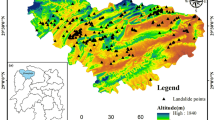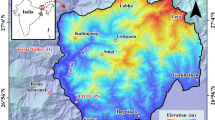Abstract
Landslide susceptibility mapping is still an ongoing requirement for variety of applications such as land use management plans. The central objective of the present research was to investigate the effect of using ensemble machine learning methods for developing accurate landslide prediction. We aimed to explore and compare three techniques, namely the random forests, support vector machine and multiple-layer neural networks with an adaptive neuro-fuzzy inference system, which incorporates three metaheuristic methods including grey wolf optimization, particle swarm optimization, and shuffled frog leaping algorithm for landslide susceptibility assessment in the East Azerbaijan of Iran. Also, two ensemble ways (voting and stacking) were used in final decision stage. A sum of 766 locations with landslide inventory was recognized in the context of the study. Then the all models were trained using tenfold cross-validation technique. Lastly, the receiver operating characteristic and statistical procedures were employed to validate and contrast the predictive capability of the models. The findings of the study show the ANFIS–PSO model had high performance on the validation dataset (AUC = 0.89). Besides, the study revealed that using stacking ensemble technique could increase the predicting capability of all models (AUC = 0.911).
















Similar content being viewed by others
Data availability
The datasets generated during and/or analyzed during the current study and source codes are available from the corresponding author on reasonable request.
References
Abdollahizad S, Balafar MA, Feizizadeh B, Babazadeh Sangar A, Samadzamini K (2021) Using hybrid artificial intelligence approach based on a neuro-fuzzy system and evolutionary algorithms for modelling landslide susceptibility in East Azerbaijan Province Iran. Earth Sci Inform 14(4):1861–1882
Aghdam IN, Varzandeh MHM, Pradhan B (2016) Landslide susceptibility mapping using an ensemble statistical index (Wi) and adaptive neuro-fuzzy inference system (ANFIS) model at Alborz mountains (Iran). Environ Earth Sci 75(7):1–20
Alizadeh M, Alizadeh E, Asadollahpour Kotenaee S, Shahabi H, Beiranvand Pour A, Panahi M et al (2018) Social vulnerability assessment using artificial neural network (ANN) model for earthquake hazard in Tabriz city Iran. Sustainability 10(10):3376
Bayat M, Ghorbanpour M, Zare R, Jaafari A, Pham BT (2019) Application of artificial neural networks for predicting tree survival and mortality in the Hyrcanian forest of Iran. Comput Electron Agric 164:104929
Chen W, Pourghasemi HR, Naghibi SA (2018) A comparative study of landslide susceptibility maps produced using support vector machine with different kernel functions and entropy data mining models in China. Bull Eng Geol Env 77(2):647–664
Chen W, Tsangaratos P, Ilia I, Duan Z, Chen X (2019) Groundwater spring potential mapping using population-based evolutionary algorithms and data mining methods. Sci Total Environ 684:31–49
Chen W, Xie X, Wang J, Pradhan B, Hong H, Bui DT et al (2017) A comparative study of logistic model tree, random forest, and classification and regression tree models for spatial prediction of landslide susceptibility. Catena 151:147–160
Costache R, Hong H, Wang Y (2019) Identification of torrential valleys using GIS and a novel hybrid integration of artificial intelligence, machine learning and bivariate statistics. Catena 183:104179
Elmoulat M, Debauche O, Mahmoudi S, Mahmoudi SA, Manneback P, Lebeau F (2020) Edge computing and artificial intelligence for landslides monitoring. Procedia Comput Sci 177:480–487
Fang Z, Wang Y, Peng L, Hong H (2020) Integration of convolutional neural network and conventional machine learning classifiers for landslide susceptibility mapping. Comput Geosci 139:104470
Feizizadeh B, Gheshlaghi HA, Bui DT (2021) An integrated approach of GIS and hybrid intelligence techniques applied for flood risk modelling. J Environ Plan Manage 64(3):485–516
Gheshlaghi HA, Feizizadeh B (2017) An integrated approach of analytical network process and fuzzy based spatial decision making systems applied to landslide risk mapping. J Afr Earth Sci 133:15–24
Ghorbanzadeh O, Blaschke T, Gholamnia K, Meena SR, Tiede D, Aryal J (2019) Evaluation of different machine learning methods and deep-learning convolutional neural networks for landslide detection. Remote Sens 11(2):196
He Q, Shahabi H, Shirzadi A, Li S, Chen W, Wang N et al (2019) Landslide spatial modelling using novel bivariate statistical based Naïve Bayes, RBF classifier, and RBF network machine learning algorithms. Sci Total Environ 663:1–15
Hong H, Liu J, Bui DT, Pradhan B, Acharya TD, Pham BT et al (2018) Landslide susceptibility mapping using J48 Decision Tree with AdaBoost, bagging and rotation forest ensembles in the Guangchang area (China). Catena 163:399–413
Kalantar B, Pradhan B, Naghibi SA, Motevalli A, Mansor S (2018) Assessment of the effects of training data selection on the landslide susceptibility mapping: a comparison between support vector machine (SVM), logistic regression (LR) and artificial neural networks (ANN). Geomat Nat Haz Risk 9(1):49–69
Lee S, Lee M-J, Jung H-S, Lee S (2020) Landslide susceptibility mapping using Naïve Bayes and Bayesian network models in Umyeonsan Korea. Geocarto Int 35(15):1665–1679
Li Y, Chen W (2019) Landslide susceptibility evaluation using hybrid integration of evidential belief function and machine learning techniques. Water 12(1):113
Nhu V-H, Shirzadi A, Shahabi H, Singh SK, Al-Ansari N, Clague JJ et al (2020) Shallow landslide susceptibility mapping: A comparison between logistic model tree, logistic regression, naïve bayes tree, artificial neural network, and support vector machine algorithms. Int J Environ Res Public Health 17(8):2749
Pandey VK, Sharma KK, Pourghasemi HR, Bandooni SK (2019) Sedimentological characteristics and application of machine learning techniques for landslide susceptibility modelling along the highway corridor Nahan to Rajgarh (Himachal Pradesh) India. Catena 182:104150
Pham BT, Jaafari A, Avand M, Al-Ansari N, Du Dinh T, Yen HPH et al (2020) Performance evaluation of machine learning methods for forest fire modeling and prediction. Symmetry 12(6):1022
Pham BT, Prakash I (2019) Evaluation and comparison of LogitBoost ensemble, Fisher’s linear discriminant analysis, logistic regression and support vector machines methods for landslide susceptibility mapping. Geocarto Int 34(3):316–333
Pham BT, Prakash I, Dou J, Singh SK, Trinh PT, Tran HT et al (2020) A novel hybrid approach of landslide susceptibility modelling using rotation forest ensemble and different base classifiers. Geocarto Int 35(12):1267–1292
Shahri AA, Spross J, Johansson F, Larsson S (2019) Landslide susceptibility hazard map in southwest Sweden using artificial neural network. Catena 183:104225
Tien Bui D, Shahabi H, Shirzadi A, Chapi K, Hoang N-D, Pham BT et al (2018) A novel integrated approach of relevance vector machine optimized by imperialist competitive algorithm for spatial modelling of shallow landslides. Remote Sens 10(10):1538
Tsangaratos P, Ilia I (2016) Comparison of a logistic regression and Naïve Bayes classifier in landslide susceptibility assessments: the influence of models complexity and training dataset size. Catena 145:164–179
Van Dao D, Jaafari A, Bayat M, Mafi-Gholami D, Qi C, Moayedi H et al (2020) A spatially explicit deep learning neural network model for the prediction of landslide susceptibility. Catena 188:104451
Wang Y, Fang Z, Wang M, Peng L, Hong H (2020) Comparative study of landslide susceptibility mapping with different recurrent neural networks. Comput Geosci 138:104445
Zhang K, Wu X, Niu R, Yang K, Zhao L (2017) The assessment of landslide susceptibility mapping using random forest and decision tree methods in the three Gorges Reservoir area China. Environ Earth Sci 76(11):1–20
Zhao C, Chen W, Wang Q, Wu Y, Yang B (2015) A comparative study of statistical index and certainty factor models in landslide susceptibility mapping: a case study for the Shangzhou District, Shaanxi Province China. Arab J Geosci 8(11):9079–9088
Zhu A-X, Miao Y, Liu J, Bai S, Zeng C, Ma T et al (2019) A similarity-based approach to sampling absence data for landslide susceptibility mapping using data-driven methods. Catena 183:104188
Acknowledgements
The authors thank the Iranian Department of Water Resources Management (IDWRM), Iranian Statistical Institute (ISI), and Meteorological Organization (MetO) for providing whole investigation reports. We are grateful to all those who helped us for their expert comments.
Funding
No funds, grants, or other support was received.
Author information
Authors and Affiliations
Contributions
Conceptualization, SA; methodology, SA; software, SA, MB; validation, BF; formal analysis, ABS; investigation, BF; resources, KS; data curation, SA; writing—original draft preparation, KS; writing—review and editing, SA, MB and KS; visualization, ABS; supervision, BF; project administration, SA All authors have read and agreed to the published version of the manuscript.
Corresponding author
Ethics declarations
Conflict of interest
The authors declare that they have no conflict of interest.
Ethical approval and Consent to participate
Yes.
Consent for publication
Yes.
Human and animal rights
Not applicable.
Additional information
Publisher's Note
Springer Nature remains neutral with regard to jurisdictional claims in published maps and institutional affiliations.
Rights and permissions
Springer Nature or its licensor (e.g. a society or other partner) holds exclusive rights to this article under a publishing agreement with the author(s) or other rightsholder(s); author self-archiving of the accepted manuscript version of this article is solely governed by the terms of such publishing agreement and applicable law.
About this article
Cite this article
Abdollahizad, S., Balafar, M.A., Feizizadeh, B. et al. Stacking ensemble approach in data mining methods for landslide prediction. J Supercomput 79, 8583–8610 (2023). https://doi.org/10.1007/s11227-022-05006-0
Accepted:
Published:
Issue Date:
DOI: https://doi.org/10.1007/s11227-022-05006-0




